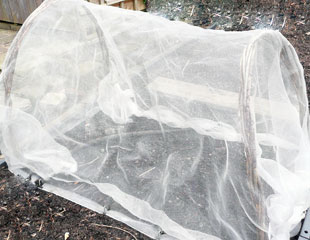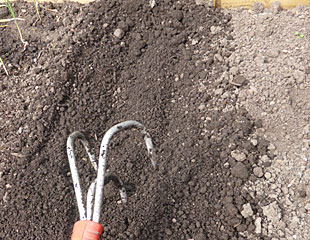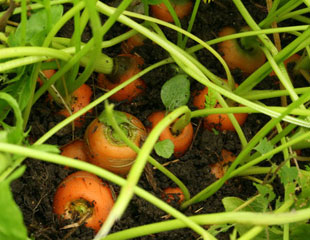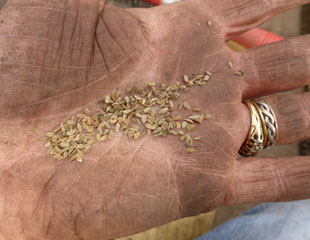


How to Grow Carrots
Growing carrots is rewarding, but it is true to say they need a fair bit of attention. The seed can be slow to germinate, seedlings need thinning, and protection from carrot fly and good soil preparation is essential before sowing or planting. All is worthwhile for a tasty sweet crop, but Carrots are fussy growers for which reason I tag them amber wheelbarrow. Supermarket Carrots are dull in comparison, home-grown offers many varieties and colours
Careful soil preparation is essential when growing carrots. This is to prevent the carrots from forking, which makes the carrots grow stunted or misshapen. The soil needs to be superprepared and raked into a fine tilth to create an ideal growing medium. If you can be bothered, it also helps to sieve the soil and remove all the lumps, this is even better. If your soil is heavy, you may need to mix in some sand to make it lighter and more Carrot friendly.
Apart from dealing with carrot fly once established carrots are fairly trouble free when grown on prepared ground. A plus point is that Carrots need little watering as they are one of the more drought resistant vegetables.
If you want to grow small sweet carrots, pick the varieties described as quick-maturing 'earlies' as the name suggests they grow fast and are ready for eating earlier. Below are the various Carrot varieties with the RHS award of garden merit, which is a good starting point.

I tag carrots amber wheelbarrow as they are not straight- forward to grow and require attention.
How To Grow Carrots from seed

Carrot seed can difficult to germinate and it is best but not essential to use fresh seed. Carrot seed does not always keep well from year to year. If Carrot seed fails to germinate (as can often happen) there can be a host of reasons; too cool, too warm, too dry or too wet; it needs ideal conditions. If the Carrot seed fails, sow again, and if need be, again. Some years it seems to germinate is "just like that", another year it perversely refuses and more sowings are needed.
EU regulations reflect the varying rates of germination, and still seem to apply. When retailing carrot seed it has to have a minimum only of 65% germination rate compared with say runner beans at 80%. It is definitely a case of sow again and if more than one failure from the same packet, maybe another packet of seed. Carrot seed will not readily germinate at temperatures below 7.5C
Carrots are best sown or planted where you want them to grow; Carrots dislike to be moved, which is why it is best, if you can, to grow them from seed.
Sow Carrots into ground which has not been recently manured otherwise they will tend to "fang" Carrots do not need soil which is enriched, they have a preference for sandy soil and neutral in terms of pH.
Sow Carrot seed into shallow drills, about 15mm deep, rows 15cms apart and as thinly as you can manage. Cover with just a sprinkling of soil water and wait. Wait and sometimes wait a while. Carrots and Parsley are both members of the same plant family (Umbelliferae) often slow to germinate, and in a cool spring you may need to re seed if the conditions are not ideal. Carrots can be sown from March onwards, although bear in mind Carrot seed needs 7 degrees to germinate, and they are likely to need protection with fleece or cloches.
How to prevent Carrot fly

Protection against carrot fly needs to be in place as soon as the carrots have germinated or immediately on planting. Prevention is by a physical barrier as illustrated in the image top left. Carrot fly will also attack related vegetables such as parsnip, parsley, celery and celeriac. Growing, and especially thinning out the Carrots, releases the carrot smell, which attracts carrot fly, a destructive pest.
It is a small black-bodied fly whose larvae feed on the roots of Carrots and eat the developing Carrots, causing them to rot. Carrot fly is a low-flying pest, which is why, the barrier needs to be about 45cms high which they cannot fly over. As long as the plants are protected, the carrot fly cannot lay its eggs which hatch into tunnelling maggots in your carrots.It is preventable, but it's a bit of a faf, in that the only sure-fire way to prevent Carrot fly is to erect a physical barrier using very fine mesh as in the image. You need to make a support around the area where the Carrots are growing, wrap the protection over the supports, and then pin it down securely. This means when weeding, thinning and harvesting, it is necessary to unpin and lift the mesh. The barrier does work. It is very effective at keeping Carrot fly away and prevents an attack.
Other suggestions are to plant onions or garlic nearby as a companion with a different smell to mask the Carrots. In addition, there are varieties of Carrot sold which are resistant to Carrot fly, such as 'Flyway' and 'Resistafly' although they are not 100% resistant.
Many veg are suitable for growing in containers.
How and Why to Thin Out Carrots
It is essential to thin carrots out once they have germinated. This is because the carrot seed is fine, which makes it's easy to get too much seed in the drills and bunching. When seedlings grow too close together there is not enough space between plants for them to develop. Thinning out means that you reduce the crop by ruthlessly pulling out some germinated seedlings to make more room for the remaining plants. The remaining plants will grow better with more space and ideally make about 5cms minimum between seedlings. If time permits, a feed every two weeks will help produce strong growth. Carrots especially dislike competition from weeds.
Best Carrots for Growing in Containers

It is possible to grow Carrots in containers if you are short of space or have very stoney ground. If you are growing Carrots in containers, remember Carrots like a good root run, i.e a good depth, so you need either a deep container, at least 25cms deep or grow a shallow short variety of Carrot. You may also wish to consider a shorter variety of Carrot if growing in heavy ground. It is also important to replicate the best growing conditions, which means fine, free draining soil with no lumps and which runs freely, sieved is best. Also essential will be to protect the carrots in the container from carrot fly with mesh.
Helpfully, in 2010 the RHS undertook a trial to establish which varieties of Carrot are most suitable for containers and best early varieties and the results of their trial are: Marion F, Parmex (a very short variety,) Adelaide F which described as sweet flavoured, Parano, Nantes 1087 F, Mokum F, Napoli F, Primo F, Trevour F, and Yukon.
Carrots which have the RHS award of Garden Merit are: 'Resistafly' a Nantes type with some resistance to carrot fly; 'Eskimo' all rounder that is winter hardy, particularly in well-drained conditions; 'Deep Purple' unusual colour; 'Artemis' smooth skinned good as baby carrot.
There are also seeds sold which produce a mixed range of colours for Carrots sold as 'Rainbow' Mix which as the image shows produces multi coloured carrots. Most of the garden centres and on-line web retailers have a wide range of carrots including the multi coloured variety. Originally carrots were purple and white, the orange carrot only made its appearance in the 1700.
There are 7 main types of carrots:
Nantes which can be earlies or main crop and form a cylindrical carrot. They are widely grown commercially.
Amsterdam forcing are a mainly slender carrot with cylindrical roots
Chantenay has conical roots and is good for shallow soil and containers, Berlium similar but smaller.
Autumn King large carrot but maybe not as tasty
Globe has shallow roots and good for growing in containers and grow bags
Imperator mainly grown in US.
When to Harvest Carrots
How do you know when carrots are ready to harvest? It takes between 12 and 16 weeks depending on growing conditions and the variety. This is often around June/July time, although you can pick as baby carrots and harvest as soon as they are big enough to eat. Sometimes you can't tell, there is good top growth but what's below ground?
One way is to gently scrape away some earth and feel down to check the size of the carrot. Check the ones with the most top growth as they will be the largest. Some varieties will crop earlier and it's worth checking the seed packets. You can leave carrots in the ground until Autumn and later. I have harvested carrots for Christmas day lunch. If you lift them, store in the cool and dark, a garage is ideal.
